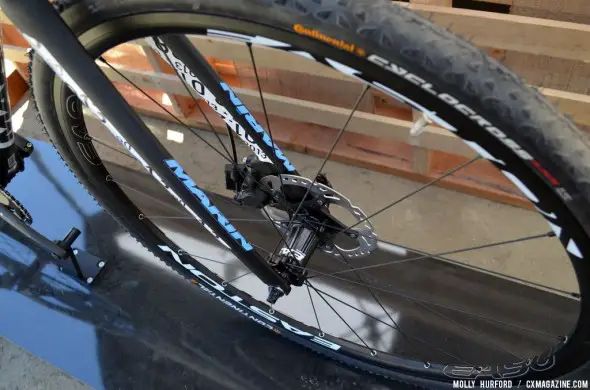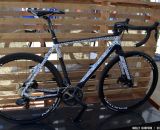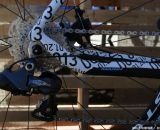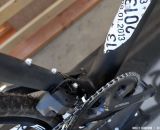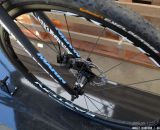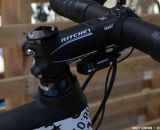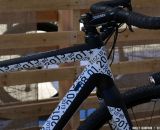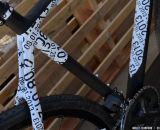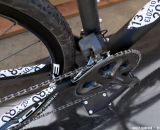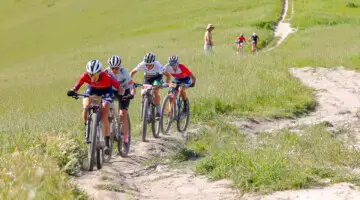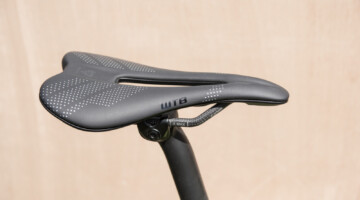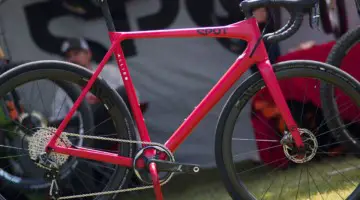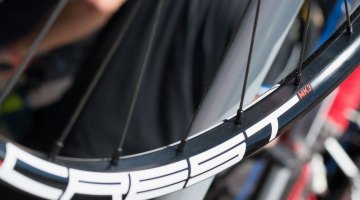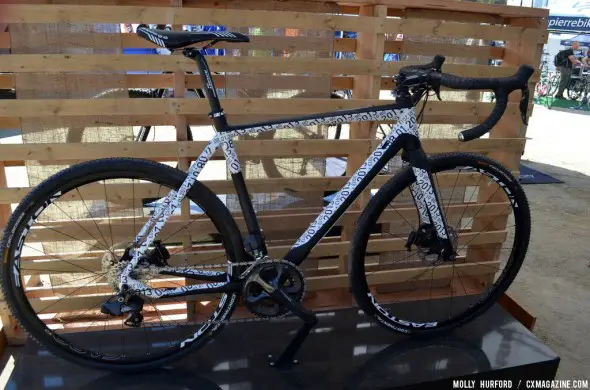
The Marin Cortina has been aluminum, until now, with the carbon frame for 2014. © Cyclocross Magazine
With sunny skies and perfect temperatures, the Sea Otter Classic started with a bang, showcasing racers and new products in the same venue in Monterey, California. Among the exhibitors was the local Marin Bikes, located just two hours north of the event. Marin was showing off their all new carbon version of the Marin Cortina, their only cyclocross-specific offering.
“The Cortina goes carbon, finally,” said Mark Vanek, the Product and Marketing Manager who was heavily involved with the making of the bike. “It’s been in the lineup since 1999, in different iterations, as aluminum.” (Sea our profile of the 2012 aluminum model here).
“We wanted to make the bike a little more competitive, weight-wise, for racers. We’re going to do two models, a top-tier level and then a bullet-point spec, blue collar version as well. That’s where the Cortina has always sat: the 2013 bike had a SRAM drivetrain, we’ve always put the money where it mattered, and that’s been having a clutch rear derailleur [2013 has a SRAM’s XO Type 2 rear derailleur] on the bike.”
They use a T3–tube to tube–construction, which Vanek says, “Really allowed us to be creative tuning ride quality and creating a bike that’s a pretty optimal weight for stiffness and reliability.” The Cortina frame will weigh around 900 grams, though the exact final weight isn’t determined yet since they’re still tweaking the frame.
The seat tube has a larger diameter at the bottom near the bottom bracket for stiffness, but it tapers for a fit of a 27.2mm seatpost. “We want the top end of the bike to be super compliant,” Vanek explains.
The cable routing is set up for internal routing of either electronic wires or mechanical cables. “It allows the rider to set up the bike with electronic or internal mechanical, or if you want to run full-length housing internally, you can do that as well.” And for the Di2 users, the battery will be internal seat post style, which is charged at the front junction box under the stem, so riders won’t have to remove the seatpost.
The show model is set up with Shimano Ultegra Di2, with a Ritchey saddle and stem, PF30 bottom bracket and Easton EA90 wheels (as reviewed in Issue 20) with Continental Cyclocross tires, as the “pro level” version. There will be a “budget version” for the “racer who needs the hot rod parts where they really count.” There’s a full carbon fork made by Marin on the top-tier version, while the budget version will have a similar fork with an aluminum steerer.
The rear spacing is set up, as one would imagine, for disc brakes, with 135mm spacing, and Marin sets the bike up for a 160mm rotor. “People who use our bike are often gravel racers as well, and we don’t think the 140 gives riders the best braking in all conditions,” Vanek adds.
The MSRP has yet to be determined, but Vanek says that they’re aiming for the bike to not be much more expensive than the aluminum model (MSRP $1899.99). The bike will be available for the fall, and the goal is “to be here by ’cross season.”
And for those who still are hoping for an even more budget-friendly option, “We do have another bike in our lineup, the Lombard, that will stay aluminum. It’s always been more of a double-duty bike. It sits in the ’cross family, so it shares the same geometry, but it’s built in ‘street-clothing.'”
We recently reviewed last year’s model of the Marin Cortina in Cyclocross Magazine Issue 19, and readers can find specs on that aluminum build here.
Stay tuned for more from Sea Otter!













